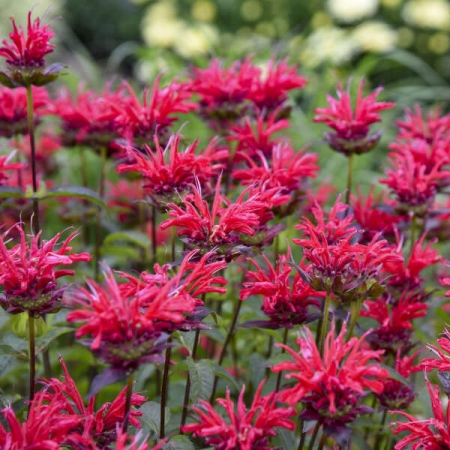Monarda (Bee Balm)
×
Color Name: Upscale® Red Velvet
Prepare for Red Velvet Bee Balm to raise your expectations with a robust, substantial landscape presence. Taller than most other Bee Balms on the market, Red Velvet averages 2-2½' tall and wide with flowering performance that covers the top half of the plant. It is excellent for landscape plantings and filling space in the middle of the border. Well branched stems support a second flush of flowers that extends the length of bloom, a trait that will delight both gardeners and the bees who frequent this popular pollinator perennial. Red Velvet exhibits good mildew resistance.
Red Velvet has large cherry red flowers. The tallest variety in the collection. Newly emerging foliage has a bronze cast.
Monarda is native to eastern North America, so it is easy to grow and it multiplies quickly. The flowers' sweet nectar attracts scores of hummingbirds, butterflies, and bees to the garden. The aromatic foliage smells like mint when crushed and is often used to flavor teas.
Growing Tips: Monarda can be found naturally along riverbanks and enjoys this rich, organic, moist soil. However, it will grow in average soil as well. Full sun is best, but light shade is tolerated. Plants tend to spread more quickly in the shade, however.
Most monardas multiply rapidly either by underground stems or self-sowing. Deadheading spent blooms will prolong the bloom time.
Powdery mildew is a common fungal problem with monarda. Some varieties are more resistant to it than others. To prevent this fungus from appearing, large clumps should be thinned out so that the air circulates freely around them. The soil should also be kept consistently moist; dry soil promotes powdery mildew.
Photo courtesy of Walters Garden, Inc.
Prepare for Red Velvet Bee Balm to raise your expectations with a robust, substantial landscape presence. Taller than most other Bee Balms on the market, Red Velvet averages 2-2½' tall and wide with flowering performance that covers the top half of the plant. It is excellent for landscape plantings and filling space in the middle of the border. Well branched stems support a second flush of flowers that extends the length of bloom, a trait that will delight both gardeners and the bees who frequent this popular pollinator perennial. Red Velvet exhibits good mildew resistance.
Red Velvet has large cherry red flowers. The tallest variety in the collection. Newly emerging foliage has a bronze cast.
Monarda is native to eastern North America, so it is easy to grow and it multiplies quickly. The flowers' sweet nectar attracts scores of hummingbirds, butterflies, and bees to the garden. The aromatic foliage smells like mint when crushed and is often used to flavor teas.
Growing Tips: Monarda can be found naturally along riverbanks and enjoys this rich, organic, moist soil. However, it will grow in average soil as well. Full sun is best, but light shade is tolerated. Plants tend to spread more quickly in the shade, however.
Most monardas multiply rapidly either by underground stems or self-sowing. Deadheading spent blooms will prolong the bloom time.
Powdery mildew is a common fungal problem with monarda. Some varieties are more resistant to it than others. To prevent this fungus from appearing, large clumps should be thinned out so that the air circulates freely around them. The soil should also be kept consistently moist; dry soil promotes powdery mildew.
Photo courtesy of Walters Garden, Inc.
|
Flower Color: Red Shades Foliage Color: Green Shades
Height: 30 to 34 Inches Spread: 34 to 38 Inches Hardy in Zone: 5, 4, 6, 7 |
Blooms: Late Summer Mid-Summer
Foliage Season: All Season |
Growth Rate |
Medium
|
Attributes |
Fragrant Extended Bloomer Native Landscapes Easy to Grow Disease Resistant Cut Flower or Foilage Border Mass Planting
|









